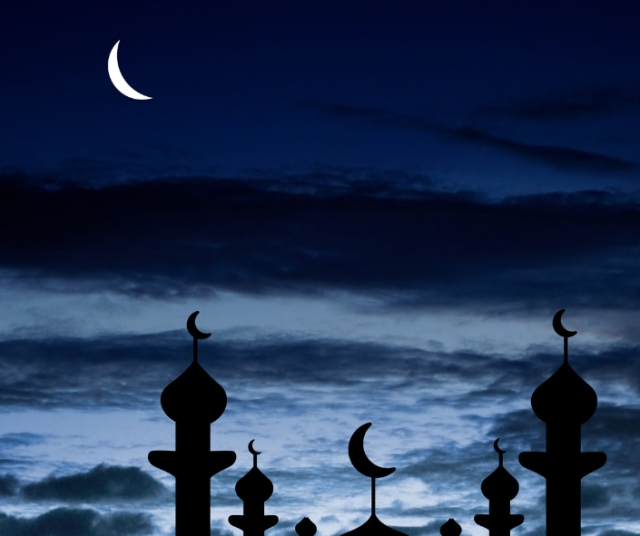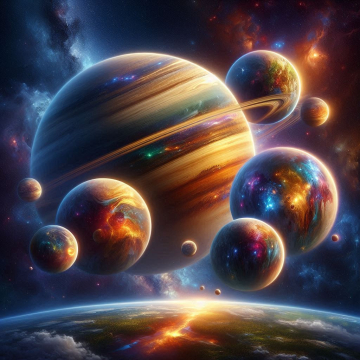The Moon, that mysterious and celestial object that illuminates us at night, has captured the imagination of humanity since time immemorial. Throughout history, the Moon has played a crucial role in the evolution of religions and spiritual beliefs of different cultures around the world.
You might be interested: What influence does the moon have on the oceans?
The Moon as a Symbol of Divinity
From ancient civilizations to contemporary religions, the Moon has been considered a symbol of divinity and spiritual power. In many cultures, it has been attributed divine status and associated with important gods and goddesses. Let's look at some notable examples:
The Moon in Greek Mythology
In Greek mythology, Selene was the goddess of the Moon, one of the original Titanesses and sister of Helios, the god of the sun, and Eos, the goddess of the dawn. Selene was depicted as a beautiful woman who drove a chariot through the night sky, illuminating the earth with her silver light. His figure embodied the beauty and mystery of the Moon, and his cult was widely revered in ancient Greece.
The Moon in Hindu Tradition
In Hindu tradition, the Moon is associated with the god Chandra, who personifies mind and emotion. Chandra is considered as the provider of light that illuminates the darkness of ignorance. Furthermore, in Hindu mythology, the Moon is also related to the goddess Ganga, the goddess of the Ganges River, whose waters are said to be related to the Moon.
The Moon in the Islamic Religion
In Islam, the lunar calendar plays a key role in determining religious dates and holidays, such as Ramadan. Additionally, the Moon is mentioned in several verses of the Quran and is used as a symbol of divine creation. The observation of the new Moon is essential for the beginning of the Islamic months, showing the direct influence of the Moon on Islamic religious practice.
These are just a few examples of how the Moon has been venerated in different religious traditions. Its lunar cycle, which spans approximately 29.5 days, has also influenced the organization of religious festivities and rituals in various cultures.
The Moon in Religious Rituals
The Moon has played a fundamental role in religious rituals throughout history. Its monthly cycle has been an important temporal marker for many religious celebrations, and has been used to determine the dates of sacred festivities and ceremonies. Here are examples of how the Moon has influenced religious rituals:
The Phases of the Moon in Hinduism
In Hinduism, the phases of the Moon are crucial for determining festivities and rituals. The festival of Karva Chauth, in which wives fast from dawn to full moon for the health and longevity of their husbands, is a prominent example. Furthermore, the festival of Diwali, which marks the return of Lord Rama after his exile, is celebrated on the new moon night of Kartik, according to the Hindu calendar.
The Islamic Lunar Calendar
The Islamic calendar is a lunar calendar based on the cycle of the Moon, and is used to determine Islamic religious dates, such as the beginning and end of Ramadan. The sighting of the new moon marks the beginning of each Islamic month, and this has a direct impact on the religious life and rituals of Muslims.
Christian Easter
In Christian tradition, the date of Easter is calculated based on the Moon. It is celebrated on the first Sunday after the first full moon following the spring equinox. This lunar calculation is fundamental for one of the most important Christian holidays, which commemorates the resurrection of Jesus.
Lunar Rites in Traditional Religions
In many traditional religions and indigenous cultures, rituals linked to the phases of the Moon are carried out. These rituals are often related to agriculture, hunting, fertility, and connecting with ancestral spirits. The Moon is considered a spiritual guide and time marker for these communities.
The Moon as a Symbol of Duality and Cycle of Renewal
The Moon has also become a symbol of duality in many religions and spiritual beliefs. Its monthly cycle of growth and decline has been interpreted as a metaphor for life and death, rebirth and transformation. Here are examples of how the Moon represents this duality:
Yin and Yang in Taoism
In Taoism, the duality of the Moon is reflected in the concept of yin and yang. The Moon is considered a manifestation of the yin principle, which represents darkness, passivity and femininity. The sun, in contrast, represents the yang principle, which symbolizes light, activity and masculinity. The interaction between yin and yang is essential for balance and harmony in Taoist philosophy.
The Moon in Neopaganism
In many neo-pagan traditions, such as Wicca, the Moon is a central figure. A number of symbolisms are attributed to her, including the Triple Goddess, representing the Moon in its maiden, mother and crone phases. This representation symbolizes the cycle of life, death and rebirth.
The Moon in Buddhism
Although Buddhism does not worship the Moon itself, its symbolism has influenced the Buddhist worldview. In some Buddhist schools, the Moon is used as a metaphor to illustrate the ephemeral nature of existence and the need for liberation from the cycle of rebirth (samsara).
The Moon as a Source of Spiritual Inspiration
The Moon has been a source of inspiration for poets, artists and mystics throughout history. Its beauty and mystery have led to the exploration of spiritual themes in poetry, art and literature. Here are examples of how the Moon has inspired spiritual creativity:
Poetry and Literature
From Shakespeare's sonnets to Japanese haikus, the Moon has been a recurring motif in poetry and literature. It has been used to express emotions, reflect on human nature, and evoke a sense of mystery and wonder.
Art
The Moon has been a muse for artists of different times and cultures. Painters such as Vincent van Gogh and Caspar David Friedrich have captured the beauty of the Moon in their works. The depiction of the Moon in art is often associated with spirituality and contemplation.
Mysticism and Spirituality
In mystical traditions, the Moon is often interpreted as a symbol of the connection between the divine and the earthly. It is believed that contemplating the Moon can lead to states of meditation and deeper spiritual experiences.
The Moon and its relationship with religion are a testimony to the profound influence that natural phenomena have on human spirituality. Throughout history, the Moon has been revered as a divinity, inspired religious rituals, and symbolized duality and the cycle of renewal in a variety of spiritual beliefs and traditions. Furthermore, its beauty has served as a source of inspiration for human creativity in the form of poetry, art and mysticism. The Moon continues to be a constant reminder of the connection between the cosmos and spirituality in all cultures around the world.






